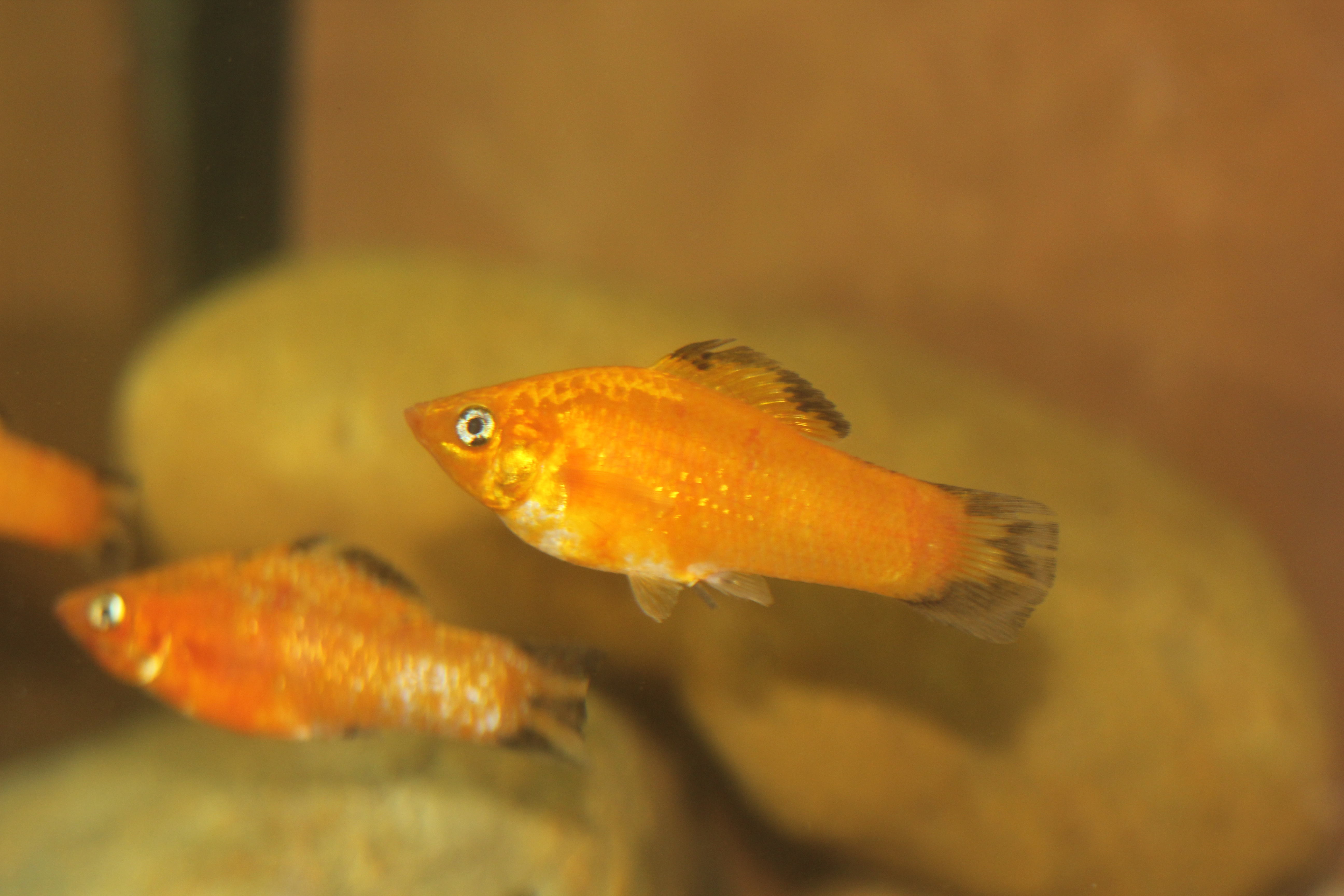About a year ago, I was sorting through some Peaches & Cream Sailfin Mollies when I noticed a very orange young male. I set him aside for breeding, giving him seven young Peaches & Cream females. Today, after a couple more generations, I’m approaching my goal of an orange sailfin.
The photo shows a couple of juveniles. The fish in focus is likely to be male and I think the other will also be male. They show some faults, one being the black streaks in the fins. This is a typical fault of their ancestral Peaches & Creams, which itself is the result of the ancestry of that color strain. An early founding male for that strain had some black streaks. We select against it, but it appears from time to time. The other fault shows in the more out of focus male. He shows some cream coloration in his caudal peduncle (area in front of the tail). Ultimately, I hope to develop a strain that is solid orange with no black streaking or cream freckling. As with most commercial molly strains, which rarely breed 100% true, I’ll have to continually select the best of each generation to maintain the line.
How will I develop this strain? I’ll do it pretty much the same way I develop any other commercial livebearer or new peacock cichlid strain. It’s a long process. First, I see a fish that shows some promise. I then imagine what a perfected strain would look like.
If the founding fish is male, I give him several related females, preferably sisters or half-sisters. If working with Poeciliidae livebearers (guppies, mollies, swords, platies, and the like), I usually discard the first batch of fry since it’s not likely my founding male is the father of those. If he’s fertile, then most if not all of the subsequent fry will be his. If you wonder why I say most, Poeciliidae females can store sperm from previous matings, so some fry may have different fathers. As soon as his fry are mature, I sort through them to see if any resemble him. I select the best females as breeders. If one of his sons is better than he is, he’s replaced by the son and the selected females are placed with their brother or half-brother. This time I don’t discard the first fry since the original male is likely the father of them. I continue this process generation by generation until I either get the fish I want or give up trying.
If the original fish is female, I mate her to a male most closely resembling her or which is at least closely related. As soon as I find an acceptable son, he is given a harem of relatives, often including his mother.
Occasionally, during this process I find an unrelated fish that exhibits the characteristics I want. I then will usually set up an outcross but will maintain the original line separately just in case the cross doesn’t work out.
One might wonder, given the bad rap inbreeding has, how do I avoid the dreaded (and mostly mythical) “inbreeding depression.” First, I try to raise lots of fish so I can select the few best and avoid fish with genetic problems. Inbreeding allows you to rapidly purge a population’s gene pool of delirious genes while accumulating beneficial genes. We’ve inbred mollies for generations and still produce some of the healthiest and most robust fish available. The Xiphophorus Genetic Stock Center at Texas State University has a line of Xiphophorus maculatus inbred via brother/sister matings for more than 140 generations. This line is perfectly healthy and devoid of deformities or weaknesses.


Chris Stevens says
Great blog. I immensely enjoy reading all of your articles on breeding even if they sometimes repeat the same information, which is good. I have learned so much from reading your blogs and they also invoke constructive thoughts on how to maintain my own fish. I don’t have a breeding room let alone a fish room per say but what I do have is your informative blogs to encourage me with what I have. Learning is fun. Thank you.